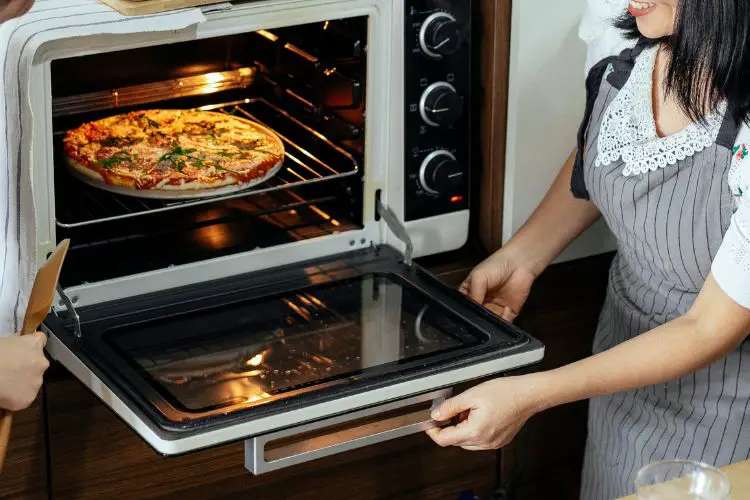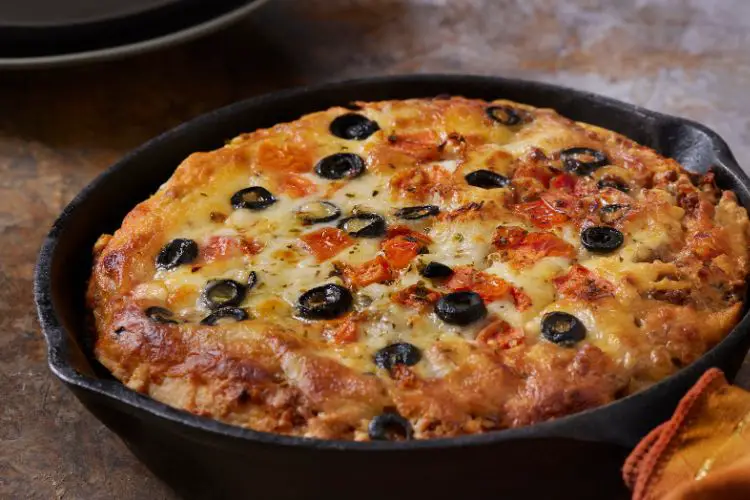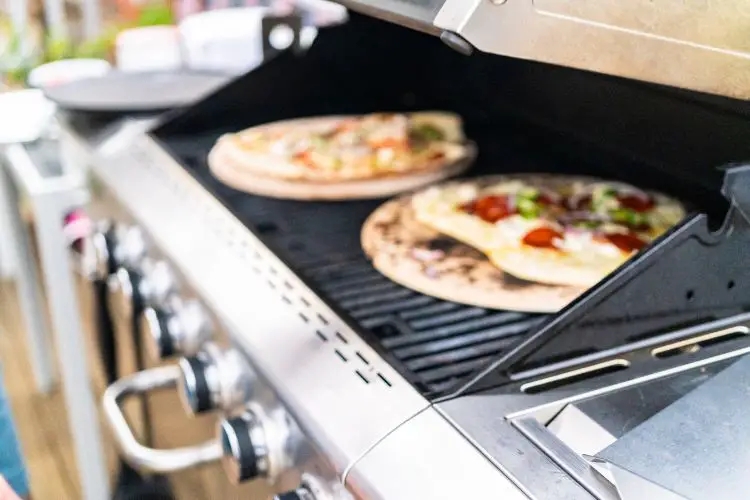Suppose, you get home late from work, and all you want is a slice of warm, cheesy pizza from the box you brought home from lunch. Now, you wonder, “Can you put the pizza box in the oven?” Even though it might seem easy, this could be a dangerous mistake. In this article, we will answer this common question and talk about how safe it is to reheat your favorite slice of pizza directly in its box. You will also learn the risks of putting a pizza box in the oven with a strong focus on safety. So, let’s get down to what really matters.
Can You Put Pizza Box in Oven?
To answer the question “Can you put a pizza box in the oven?” one must first know what materials pizza boxes are made of. It’s not safe to put them in an oven because of how the materials they’re made up of react to heat.
Most pizza boxes are made of corrugated cardboard, which is used because it is strong and has good insulation qualities. This makes it possible for the box to keep your pizza hot and to be strong enough to carry the pizza without damaging it. The flutes in the folded cardboard make air holes that prevent heat from escaping and keep your pizza warm for longer.

Chemicals are often put on the cardboard used for pizza boxes to make it resistant to oil and wetness from the pizza. This keeps the box from getting too wet and changing its shape. Even though these chemicals are good for carrying and storing pizza, they can be dangerous if heated to high temperatures in an oven.
Pizza boxes often have paints and glue on them as well. The paints are used to put the brand name and other details on the box, and the glue holds the box together. When heated to high temperatures, these things may release fumes that are dangerous for your health.
The Relationship Between Pizza Boxes and Heat
The relationship between pizza boxes and heat is interesting. The material and shape of the boxes are carefully picked so that the pizza stays warm while it’s being transported. But it’s important to remember that this relationship changes a lot when the heat level goes up, like when you put a pizza box in an oven.
Corrugated cardboard is used to make most pizza boxes because it is strong and keeps things warm. This insulation works by trapping air within the fluting of the cardboard. Since air is not a good heat conductor, it slows down heat transfer and keeps your pizza warmer for longer. This method works well at lower temperatures and is ideal for the short journey from the restaurant to your home.
But these insulation qualities don’t work when the temperature is higher, like in an oven. At about 427 degrees Celsius, or 800 degrees Fahrenheit, the cellulose fibers in cardboard start to break down and catch on fire. The exact temperature depends on a number of things, such as how the cardboard is made, if it has been treated with chemicals, and how the oven has been configured.
Also, the paints and glues used to make pizza boxes have different ways of reacting to heat. Most of the time, these materials are safe at the lower temperatures that pizza boxes normally get. But they can start to break down at higher temperatures. This can cause smoke and possibly dangerous fumes to come out. Also, the grease and food particles that got into the box can change how it reacts to heat. These things can make the cardboard less likely to catch fire, which makes it even more dangerous to put in an oven.
Safe Methods to Reheat Your Pizza
To enjoy your pizza at its best, even after it has been cooled or put in the fridge, you need to know how to reheat it. Here are some safe and effective ways to reheat your pizza. Each of these methods can help you keep your pizza slice tasty while avoiding the dangers of putting a pizza box in the oven.
The Skillet Method

The skillet method is a favorite among pizza experts. It reheats your pizza well, restoring the crispy crust and melted cheese without making it dry or rubbery. Here’s what you need to do:
- Put your pan on the stove and turn the heat to medium-low.
- Put the pizza piece on the skillet and heat it for a couple of minutes.
- Add a few drops of water to the skillet (away from the pizza) and cover it for a minute or two. This will melt the cheese without burning the base. The steam will help the cheese and toppings melt and keep the crust crispy.
- Serve and enjoy once it’s warm enough for you.
The Oven Method
Reheating pizza in the oven is a great way to make it feel like it just came out of the pizza shop. Check out some safe steps to do it:
- Turn your oven’s temperature up to 375 degrees Fahrenheit.
- Don’t put your pizza pieces in the box. Instead, put them on a baking sheet or a plate that will safely fit in the oven.
- Heat the pizza for about 10 minutes, or until the cheese is melting and the crust is crispy. Keep an eye on the oven because cooking times can change.
- Remove from the oven using oven mitts and let it cool for a few minutes before serving.
The Toaster Oven Method
A toaster oven is a great way to reheat a small number of pizza slices. It heats up faster and uses less power than a regular oven. Here is the process:
- Preheat the toaster oven’s temperature to about 375 degrees Fahrenheit.
- Put your pizza slice directly on the oven rack or on a toaster oven-safe tray.
- Heat the pizza for about 5–10 minutes. Remember that toaster ovens can heat food faster than normal ovens. So, be careful while using this method.
- Remove and let it cool for a minute once the cheese is bubbly and the top is crisp.
The Microwave Method
Even though it’s not the best way to reheat pizza because it tends to make the crust mushy, the microwave is a quick and easy way to do it:
- Put a slice of pizza on a microwave-safe plate.
- Place a mug of water in the microwave with your pizza to keep the crust from getting chewy.
- Heat the pizza at 50% power for about a minute or two, or until the cheese is melting. The exact time will depend on how strong your microwave is.
- Give it a minute to cool down before you try it.
The Grill Method

Using your grill is a less popular but useful way, especially during the warmer months. So, we want to let you know about this method too. Go through the following processes:
- Preheat your grill to medium-low heat to get it ready. A temperature of about 375 degrees Fahrenheit is what you need.
- Place your pizza slices directly on the rack of the grill.
- Close the lid and let the pizza heat for about 5–7 minutes, or until the cheese is melted and the crust is crisp.
- Remove with a spatula or tongs, let cool, and serve.
The Air Fryer Method
The air fryer is the newest instrument that many homes have. It does a pretty good job of reheating pizza. Check out the process of applying this method:
- Heat your air fryer up to between 325 and 350 degrees Fahrenheit.
- Place the pizza slice in the basket, making sure that the slices don’t touch each other.
- Cook for about 3 to 4 minutes, or until the cheese is melted and bubbly.
- Give it a few minutes to cool down before you eat it.
Each of these methods is a safe and effective way to reheat pizza so that it tastes as fresh and delicious as it did when you first ate it. Even though they don’t offer the “convenience” of keeping the pizza in the box, they are safer and do a much better job. So, the next time you have pizza left over, try one of these ideas.
Also Read: Decoding the Shelf Life: How Long is Rotisserie Chicken Good For?
How to Store Leftover Pizza
To keep the taste, texture, and safety of leftover pizza, it’s important to store it the right way. The wrong way to store pizza can cause it to go bad or make you sick. So, it’s important to know how to keep it fresh and safe to eat. Let’s talk about some good ways to store your leftover pizza:
Refrigeration
Putting leftover pizza in the refrigerator is the fastest and easiest way to keep it. Here’s a step-by-step guide:
- Let the pizza cool down until it is at room temperature. But don’t leave it out for more than two hours, because germs can grow quickly at room temperature.
- Wrap each slice tightly in plastic wrap or aluminum foil. You can also put them in small, airtight containers or plastic bags that can be closed again. The goal is to keep the pizza from coming into contact with air, which can cause it to dry out and could lead to the growth of germs.
- Put the pizza in the fridge, either covered or in a container. It should last at least 3–4 days. After that, it might go bad and should be thrown away.
Freezing
Freezing is a great way to store things for a long time. It keeps the pizza’s taste and structure for a much longer time, usually up to one or two months. Wanna know how to do the steps of freezing? Here is how you should do it:
- Let the pizza cool down until it is at room temperature.
- Wrap each slice with a piece of plastic wrap and then a piece of metal foil. This double layer of protection helps stop freezer burn, which can happen when food is in the freezer for a long time. You can also use freezer bags that keep air out.
- Label the pizza with the date before you put it in the freezer so you know how long it’s been there.
- To reheat pizza that has been frozen or kept in the fridge, you can use any of the safe ways we’ve talked about so far: the pan, oven, toaster oven, microwave, grill, or air fryer method. All of these methods are safe, and each one changes the way the pizza tastes and feels in its own way.
Other Cardboard Alternatives to Use When Heating Pizza
Even though it’s not safe to reheat pizza in cardboard, especially pizza boxes, there are a number of alternatives that are. Here are some great options:
Baking Sheets or Pans
These cooking essentials are perfect for reheating pizza in the oven. They’re made to handle high heat temperatures and can help you make a top that’s crispy and well-melted cheese. Just preheat your oven and put the pizza on the baking sheet or pan.
Pizza Stones
Pizza stones are made to spread heat evenly across the pizza and make sure the crust is crisp and evenly cooked. They can be used in both normal ovens and grills and are great for reheating pizza because they recreate the high-heat environment of a pizza oven.
Cast-Iron Pan
A cast-iron pan is a great tool for reheating pizza on the stove. The heavy, thick material holds and spreads heat evenly, Therefore, the crust gets crispy and the toppings are absolutely perfect.
Oven-Safe Plates
If you only want to reheat one or two slices and don’t want to use a big pan or baking sheet, you can use oven-safe plates instead. Make sure the plate is truly oven-safe to prevent cracks or other damage.
Grill Racks
If you have a grill, using a grill rack to reheat your pizza can give it a smoky taste that’s hard to get in the kitchen.
FAQs
What temperature does a pizza box catch fire?
Pizza boxes are made of cardboard, which can catch fire at 427 degrees Celsius or 800 degrees Fahrenheit. But this can change based on things like the width of the cardboard, any coats or treatments that were applied to the material, and the conditions in the oven. Because of this, you should never put pizza boxes in the oven to keep everyone safe and prevent fires.
What happens if I accidentally heated my pizza with the box in the oven?
If you accidentally warm your pizza in the box while it was in the oven, turn off the oven immediately and use oven mitts to carefully remove the box. If the box is on fire, don’t use water to put it out. Instead, use a fire extinguisher or baking soda. After that, ensure your kitchen has enough airflow to eliminate any smoke or fumes. Heating pizza boxes is dangerous because it could start a fire.
Are there harmful chemicals in a pizza box that could be released when heated?
Yes, a pizza box could have dangerous chemicals that might come out when it gets hot. Pizza boxes often have paints, glues, and other chemicals that were used to make them. When these things are heated to high temperatures, they may give off fumes that are dangerous. Some pizza boxes might also have amounts of per- and poly-fluoroalkyl substances (PFAS), which are used to make things resistant to grease and could be dangerous if consumed.
How should I store leftover pizza?
Store leftover pizza in the refrigerator to keep it fresh and prevent bacteria growth. Before putting it in the fridge, tightly wrap it in aluminum foil or plastic wrap, or put it in an airtight container. If you keep it right, it should last for 3–4 days. Pizza can be frozen in containers that don’t let air in or in heavy-duty freezer bags.
Also Read: A Complete Guide On How To Tell If Bacon Is Cooked?
Final Words
From what we’ve learned, it’s clear that putting a pizza box in the oven is more dangerous than it is helpful. Not only is it a major fire danger because cardboard burns easily at high temperatures, but the inks and glues used to make pizza boxes could also release chemicals that are bad for your health. As a result, safety and health issues are much more important than the fact that this method is easy.
But we don’t have to give up our love of hot, tasty pizza. As we’ve shown, there are a number of safe and effective ways to heat up your pizza. If you have extra pizza, the best place to keep it is in the fridge. Keeping your pizza in the right way not only keeps it tasting good but also keeps it safe to eat. So, avoid putting the pizza box in the oven, safely reheat your leftovers, and enjoy every bite knowing it’s safe and delicious.

